I think I'll buy an old bullet-nosed Studebaker and mount a big chrome-plated javelin on the front end. (posted 12/3/13, permalink)
Luxury Cars - A History: For some time now, I've been researching the luxury car market and its evolution over time. There are a lot of myths surrounding certain luxury brands particularly the reasons behind their rise and/or demise. I've looked at sales and production data from various sources and have used these data to debunk some of the myths.
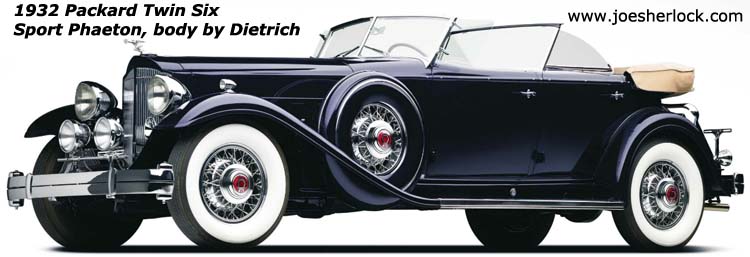
The fact is: everything changes. And evolves. The luxury auto segment is no exception.
It is fair to say, that at the dawn of the automobile age, all cars were a luxury item. Relative to personal income, autos were an expensive indulgence. In those days, trolley cars were the chief mode of public transit in most major cities. By 1895, nearly 11,000 miles of track had been built in the United States. By 1912, there were almost 40,000 miles of trackage for overhead-wire electric trolley operation in the U.S.
When Henry Ford began his assembly line in late 1913 ... (more >>>)
Everything Old Is New Again:
Nice Ride: Lots of guys lust after cool cars. I can't speak for the rest of mankind but I think my interest in owning peer-approved machinery was due to a traumatic bicycle experience in childhood.
When I was growing up, every kid - including me - wanted an AMF Roadmaster bike. Or a Schwinn Panther.
Alas, my parents bought me a base-model J. C. Higgins from Sears - the bicycle equivalent of a '49 Nash Airflite, '77 AMC Pacer or '01 Kia Rio. Or a 1953 Plymouth Cranbrook:
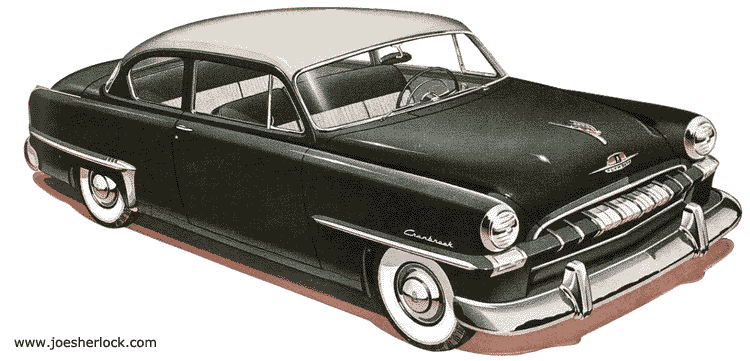
J.C. Higgins was a brand to be shunned and laughed-at by one's pre-teen peers. It was a serviceable ride - I used to buy parts for it at Pep Boys - until 8th grade when I bent the frame during a game of bicycle-chicken. (Two riders would race towards the stone wall of St. Martin of Tours grade school; the first one who turned away was 'chicken.')
I always won but I my bike finally 'lost', smashing into the wall. I only had scrapes and bruises but my Higgins was seriously damaged. I tried straightening the frame using eight-grader technology - laying the bicycle down on the front steps of our house and jumping on it vigorously - but the frame never straightened enough. The result was that the chain would always jump-off the sprockets within a block or two and the bike was unusable.
My parents wouldn't buy me a new bike, so I was forced to use foot power until I got my driver's license. (posted 10/30/13, permalink)
Happy Birthday: Henry Ford's assembly line has turned 100. On October 7, 1913, Ford's Highland Park made history when Ford installed the plant's moving automotive assembly line.
Henry simplified the labor needed down to discrete tasks that could be performed by relatively unskilled labor. Ford reduced the time required to assemble a car from 12.5 to 6 man-hours; within a year, it was down to 93 man-minutes. This made it possible for Henry Ford to cut the price of his Model Ts in half and boost production so that, in 1914, Ford made more cars than all other automakers combined.

Ford dropped the price of the Model T from $850 to $550 in 1913, and $440 in 1915. Over 500,000 Model Ts were sold in 1915.
Before the T, cars were mere playthings for the rich. Henry's Tin Lizzie didn't just put America on wheels, it put the world on wheels.
In 'Cannery Row', John Steinbeck wrote, "Someone should write an erudite essay on the moral, physical and esthetic effect of the Model T Ford on the American nation. Two generations of Americans knew more about the Ford ... planetary systems of gears than the solar system of stars." (posted 10/10/13, permalink)
Inspiring Automotive Publisher: John R. Bond was publisher of Road & Track magazine from 1949 to 1972. He was a pioneer in field of automotive writing and publishing. An engineer by training, Bond once designed motorcycles for Harley-Davidson.
Born in Muncie, Indiana on July 25, 1912, his automotive interests were encouraged by a father who was also in the automotive business. Following graduation in mechanical engineering from the General Motors Institute in Flint, Michigan in 1934, John worked with Harley-Davidson, Studebaker (from 1940 to '43) and White Truck. When he began contributing to R&T, he was a design engineer with custom and race car builder Frank Kurtis.
Road & Track magazine was founded ... (more >>>)
You'd Have To Be Cuckoo To Buy One: For $224.95, you can be the owner of a Chevy Camaro Cuckoo Clock from The Bradford Exchange. "At the top of every hour, the garage lights up to reveal a sculptural 1969 Camaro SS 396 accompanied by the sound of a revving engine!"
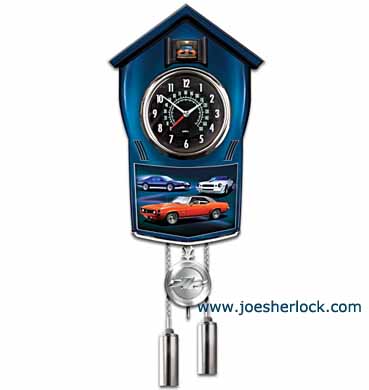
The ad I received advised me to "Hurry! Limited to 10,000!" 10,000 suckers, I suppose. It also predicted, "Strong demand is expected." From strong suckers, I guess. (posted 9/9/13, permalink)
 Soft Ice Cream & The Cold War: This is not the first time I've written about Mister Softee, the mobile ice cream vendor and perpetual butt of erectile dysfunction jokes and a familiar sight when I was growing up in Northeast Philadelphia.
Soft Ice Cream & The Cold War: This is not the first time I've written about Mister Softee, the mobile ice cream vendor and perpetual butt of erectile dysfunction jokes and a familiar sight when I was growing up in Northeast Philadelphia.
I had never heard of the 'Thrown Wrenches' website but I followed a lead from Hemmings to get there and found an interesting story about Mister Softee ice cream trucks, Civil Defense and preparedness for a nuclear strike. Who knew?
"If the Russians attacked us in the late 1950s and early 1960s, your chocolate malt would simply have to wait until after the H-bomb. You see, many franchise owners pledged their vehicle's use during an emergency as part of the Civil Defense effort. Franchise owners like Raymond Volkerding, of Cape Girardeau, Missouri told the local paper that he'd press his kitchen on wheels into service if needed.
What's more neighborly than that? You have fresh water storage, electricity for cooking, and refrigeration to keep food and beverages safe from spoilage. As it turns out, the Boyertown-built trucks were more versatile than originally thought."
Thanks, Mister Softee, for pledging to help keep us safe. I also learned that, in 1959, Mister Softee ordered 800 ice cream trucks from the Boyertown Body Works in Boyertown, Pennsylvania. (posted 9/3/13, permalink)
Resurrecting Oldsmobile: If Elliot Spritzer and Anthony Weiner can be brought back to life politically, maybe Oldsmobile can be revived too.
Last week's 'Sharknado' was a made-for-TV, cheesy-but-compelling shark thriller in which a tornado of killer sharks strikes Los Angeles and the hungry, toothy man-eaters devour a slew of clueless Californians. Sharkmainia ensued all over the internet.
I'm sure GM has the tooling for the Oldsmobile Toronado lying around somewhere. The General should put a shark front end on it, paint it in shark colors (white underbelly, fade to blue sides and top), like the Corvette Mako Shark II - as seen and photographed by me at the 1966 New York Auto Show - and sell it as the Oldsmobile Sharkonado.
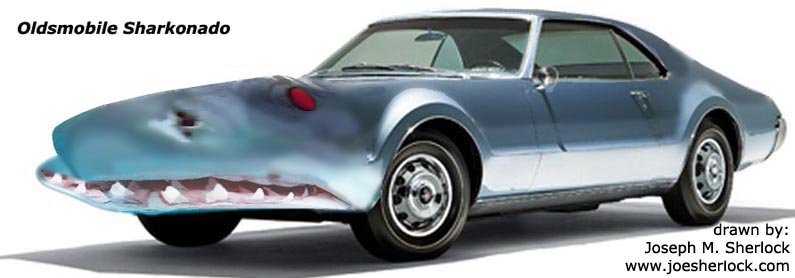
I think it would be a big hit, what with all the shark-focus going on these days.
During a recent vacation at the Oregon Coast, my son got into the shark craze, too:
Dead Dodge? An article in Ward's Auto suggests that the Dodge brand may not be long for this world.
"The brand will have no bread-and-butter midsize sedan after the Avenger ends production early next year, leaving a gaping hole in its portfolio, which already was severely trimmed by the decision to move the manufacturer's pickups from Dodge to the recently created Ram brand."
There are several ominous signs ... (more >>>)
Senseless Electrics: Recently, Didier Stevens, Toyota Europe's head of government affairs and environmental issues, said, "If the electricity is not sourced from renewables, then electric vehicles make little sense."
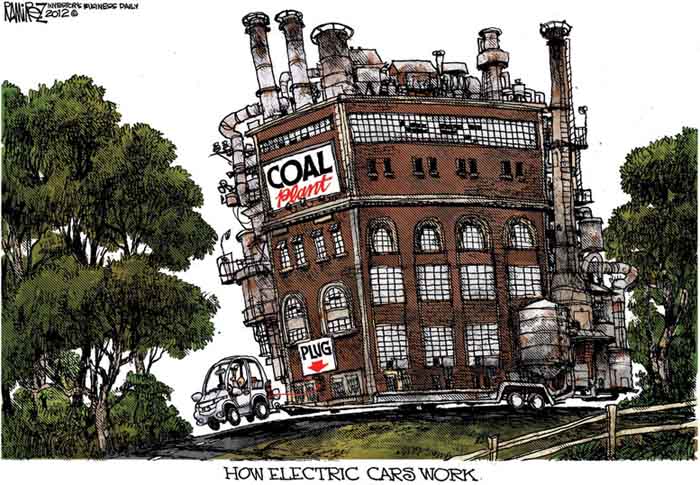
True dat. If dirty anthracite is the primary source fuel for an electric power grid, then - de facto - electric cars are not clean vehicles. Regardless of what self-styled environmentalist friends proclaim.
Electric vehicles don't make much sense in any case. Such automotive offerings will have a very limited market as long as they take many hours to 'fill up', are essentially unusable beyond a 40 to 50 mile radius from your home, can leave you 'stranded' on overnight trips and are not competitively priced compared with gasoline and hybrid vehicles.
Then there's the questionable battery life and high cost of replacement.
EVs are not the holy grail of automobiles. They weren't 100 years ago either. Just ask owners of the Baker Electric car. (posted 6/20/13, permalink)
Quiet Anniversary: The Volkswagen Beetle is 75 years old this year but you won't hear much about it from VW officials.
There's still embarrassment about the Nazi heritage of the People's Car. Hitler envisioned a small, low-cost car for the masses and commissioned automotive engineer Ferdinand Porsche to develop one. VWs were sold using a state-run savings plan, which delivered the car only after payment was made in full.
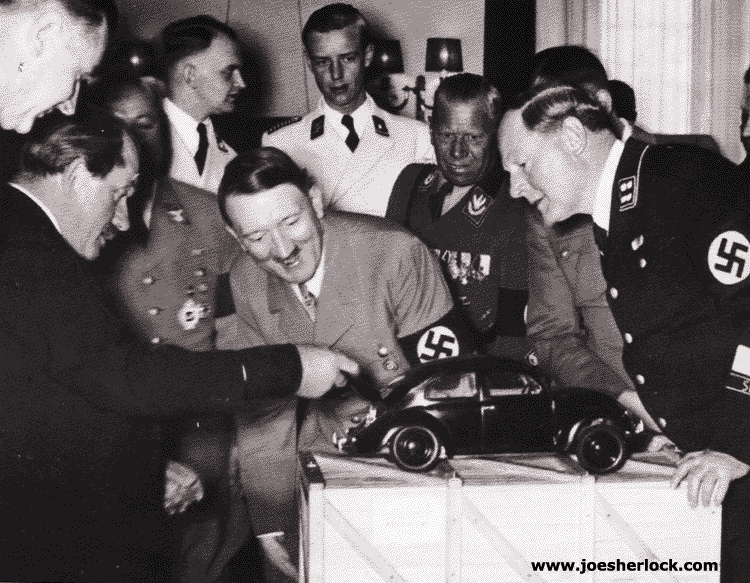
Prospective customers were given books to fill up with special stamps issued when a payment was made. When the book was full, the loyal and trusting citizen would redeem his stamp-filled booklet for a new car. Of course, that never happened. Hitler used the stamp money to finance World War II. And lost. And people never got their promised cars.
After the war, workers began assembling Volkswagens in the partly bombed-out plant. Industry titans, including Henry Ford II, looked at the homely little car and passed on factory and brand ownership opportunities.
But the car began to catch on. Only two Volkswagen Beetles were imported for the entire 1949 model year. By 1953, U.S. sales reached 1,000 per year. In 1954, 6,343 Volkswagens were sold; in 1955, the number rose to 31,000. In '57, almost 80,000 VWs found homes in the U.S. In 1959, over 150,000 were sold in America. During the summer of 1960, Volkswagen imported the 500,000th Beetle to the U.S.
 By 1961, Volkswagen had 87% of the imported vehicle market. VW's U.S. sales peaked in 1970, with 569,696. Volkswagen had captured 7% of the U.S. car market and had over a thousand American dealerships.
By 1961, Volkswagen had 87% of the imported vehicle market. VW's U.S. sales peaked in 1970, with 569,696. Volkswagen had captured 7% of the U.S. car market and had over a thousand American dealerships.
Beetles were not perfect cars but they offered a simple, honest design and were well constructed compared to American cars of the period. It taught American consumers that low-priced, reliable cars could be produced with a high quality of fit and finish.
It made people rethink their car values - perhaps other values, too. The lowly VW may have spawned a cultural revolution: did people become hippies, forsaking material values, because they bought a Beetle or did hippies just decide to buy Beetles, forsaking other kinds of cars? Hmmmm.
Beetles of one sort or another had been in our family from 1961 until 1995. They were remarkable cars, especially when one considers that the design dated from the mid-1930s.
So, despite the Hitler connection, we should all extend a hearty Happy Birthday to the iconic Beetle. (posted 6/14/13, permalink)
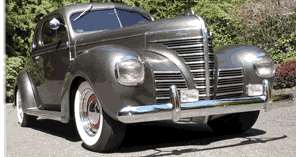 The Sky Was A Precarious Balance between Partly Cloudy and Partly Sunny on Monday - wobbling on the knife edge of the celestial scale. There had been lots of sun last week but the weather was now In Transition and rain was forecast.
The Sky Was A Precarious Balance between Partly Cloudy and Partly Sunny on Monday - wobbling on the knife edge of the celestial scale. There had been lots of sun last week but the weather was now In Transition and rain was forecast.
By 1:00 pm, the temperature was still in the low 60s. Nevertheless, I fired up my '39 Plymouth coupe and took a short drive. At some spots, I was bathed in sunshine; drive a couple of hundred feet further and the world became joyless, dull and overcast. It all depended on the capriciousness - and the location - of the many puffy, seemingly-innocuous clouds.
The ride was pleasant and almost uneventful until I came upon an unfamiliar shape racing towards me from the opposite direction. It turned out to be a red Triumph TR7 convertible. I was shocked - I didn't know there were any still on the road. I hadn't seen a TR7 of any kind in over 20 years.
TR7s were pretty small by U.S. standards of the era - only 160 inches long. Because they were so low-slung - 50 inches tall, they looked swoopy rather than stubby.
These end-of-the-line Triumphs were so unreliable and prone to rust - thank you, British Leyland - that most went to the crusher. The convertible models were fairly rare and were produced only between 1979 and '81.
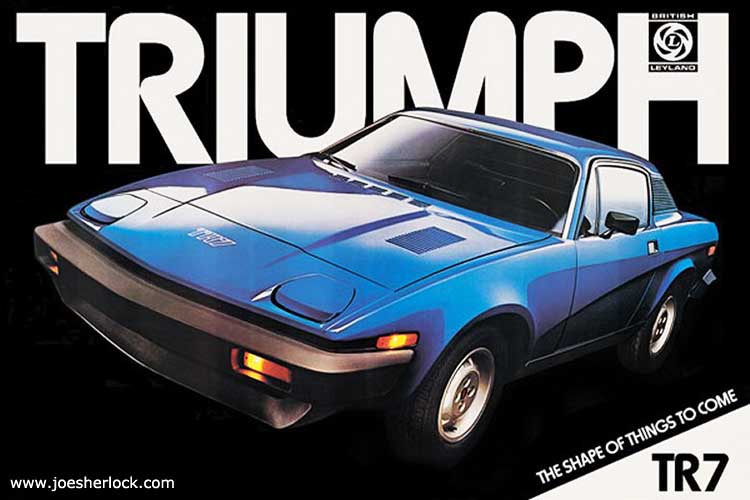
When my son was in grade school, the TR7 was his favorite car - it was pretty wedgy and futuristic-looking when introduced in 1975. He had a framed poster of one in his room. (posted 6/12/13, permalink)
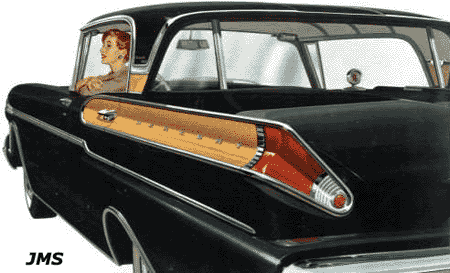 The Japanese Mercury: Acura is in trouble because it has devolved into a gussied-up Honda with almost no sales outside North America. Once destined to be a luxury car, it never really delivered.
The Japanese Mercury: Acura is in trouble because it has devolved into a gussied-up Honda with almost no sales outside North America. Once destined to be a luxury car, it never really delivered.
Its $50K-plus RL flagship is a market failure - only 273 were sold last month.
The beak-nose styling hasn't helped either. The TSX and ILX models are each selling at rates under 2,000 per month. The only Acura that sells decently is the RDX crossover - almost 5,000 of them were sold in May.
Overall Acura monthly sales are down by 1.5% from last year - to just over 14,000 units - despite Honda sales being up by over 5%
This week, AutoExtremist Peter De Lorenzo wrote, "These cars blend into the woodwork like a gray flannel suit on an overcast day. This is supposed to be the best of Honda? It sure doesn't look or feel like it. Instead, Acura still exists as a perennial symbol of the confusion that reigns at Honda. What are they doing? I'm not sure they know."
The only bright spot: Infiniti - the muffin stump of the entry-level-luxury market - is doing even worse. Its May sales were less than 7,900 - a drop of 25% from last year. (posted 6/6/13, permalink)
Motor Trends: Car windows keep getting smaller, all-wheel-drive is becoming ubiquitous, people buy SUVs to get more ground clearance, tires are becoming larger and pedestrian crash requirements are making front ends blunt and more massive.

Jeeez. In five years, we'll probably all be driving Stryker combat vehicles. (posted 5/23/13, permalink)
Nice Rack: Sometimes the titles just write themselves:
Right Now, He's Probably Pinstriping The Pearly Gates: Customizing legend Dean Jeffries has died at age 80. While in the U.S. Army stationed in Germany, he learned the art of pinstriping from a German furniture and piano striper. Upon returning to California, he continued his education under Kenneth 'Von Dutch' Howard. This lead to a job as George Barris' in-house pinstriper. Mobil Oil hired Jeffries to paint and stripe many of Indy race cars in the 1950s.
Jeffries not only striped James Dean's ill-fated Porsche 550 Spyder with the nickname 'Li'l Bastard', but, as a fabricator/builder, constructed the iconic 1932 Ford three-window coupe used on the cover of the Beach Boys' 'Little Deuce Coupe' album. Jefferies created The Monkeemobile as well as Black Beauty from the 'Green Hornet' television series and the moon buggy that James Bond steals in 'Diamonds Are Forever'.
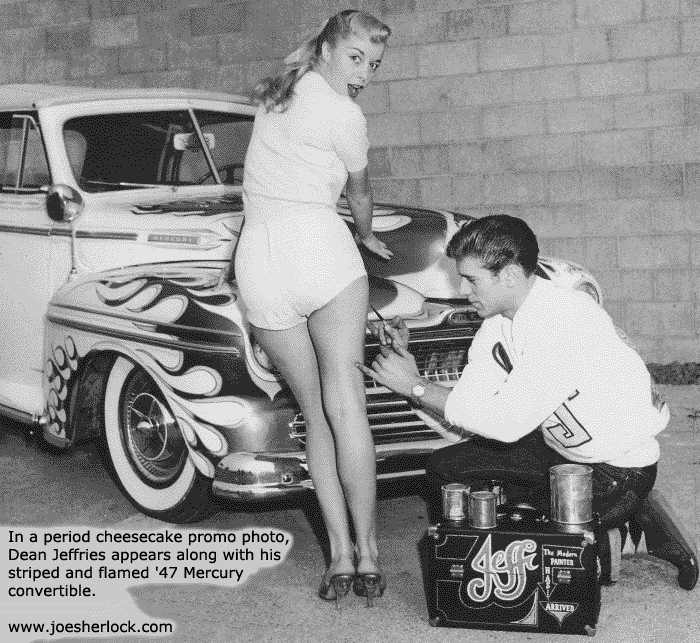
One of Jeffries' most famous custom creations was the Mantaray, an asymmetrical single-seater based on a 1939 Maserati 8CTF Grand Prix chassis. It was used in the 1963 movie, 'Bikini Beach'.
Jeffries feuded with fellow customizer, George Barris, because of Barris' habit of taking credit for Jeffries' work throughout the years. "He couldn't put a dent into something, never mind taking one out, but he's a hell of a promoter, believe me," Jeffries once said. RIP. (posted 5/9/13, permalink)
Sleek But Unobtainable: Every five years or so, Buick shows a swoopy two-door concept car and slaps Riviera badges on it. It's just another way to taunt people who lust after the concept car, then examine Buick's production line-up of chubby-looking sedans and SUVs that ape Lexus in the same way $10 timepieces hawked from sidewalk folding tables mimic Rolexes.
The latest Riviera debuted at the Shanghai Auto Show, with the intention of wetting Chinese whistles, so that eager buyers would flock to showrooms throughout the Middle Kingdom and be satisfied with a humble little sedan carrying the same Buick medallion. It's same way that a Coach luggage tag somehow confers "dignity" on cheap frangible suitcases, which - ironically - are most likely made in China.
This Chinese Riv is powered by a dual-mode wireless plug-in hybrid electric vehicle propulsion system that allows the car to be charged wirelessly just by driving atop a special charging mat on the ground. I proposed idea several years ago and pointed out that it would also be good for electrocuting garage rodents.
GM's PR minions proclaimed, "The coupe combines avant-garde aesthetics and advanced technology." I don't know about the avant-garde thing but I do know that, to my old, tired eyes, the original '63 Riv is the best-looking of the Riviera bunch.

The original Riviera was the quintessential American personal luxury coupe - an automotive market segment that began with the introduction of the 1958 four-passenger Thunderbird. Luxo-coupes like the T'Bird had bodies which were different and distinctive from those of the sedans and hardtops of the same brand.
Personal luxury coupes were usually offered with the top-of-the-line engines and higher-quality and more opulent trim. These luxo-coupes added a bit of class to the car line and were priced at the top of the brand's product offerings - the '58 Bird cost almost twice as much as the base-level 1958 Ford.
In the personal coupe biz, the Thunderbird was followed in 1963 by the Buick Riviera, in 1966 - the Oldsmobile Toronado, in 1967 - the front-wheel-drive Cadillac Eldorado and, in April of 1968, by the 1969 Lincoln Continental Mark III. By the end of the 20th Century, the personal luxury coupe market had become mostly extinct.
I wish an American-branded, production luxo-coupe would make a showroom comeback. (posted 4/25/13, permalink)
Take Me Home, Jeeves: At a recent SAE conference, several experts predicted that self-driving cars would not arrive in dealer showrooms until 2025.
Interestingly, back in 1925 or so, self-driving cars referred to the new concept of rental vehicles, the term meaning that you could drive it yourself rather than hiring a car and chauffeur. Over the years, there have been many sci-fi stories featuring automatic vehicles or robot-guided machines.
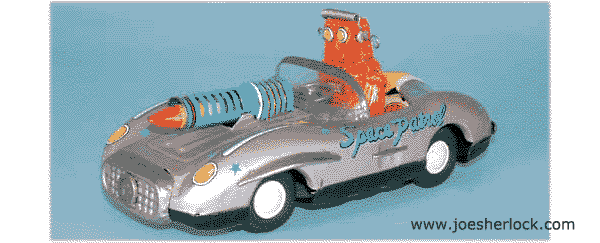
I've written about self-driving cars before. And, I think that they will arrive well before 2025. We've already got vehicles with lane change warning devices and 'smart' cruise control. Mercedes has demonstrated a self-braking car. Self-driving cars are the logical extension of these technologies.
Frankly, that's fine with me. I certainly enjoy driving on near-empty back roads but take no pleasure in navigating city traffic. Nor do I look forward to rush hour driving. I'd rather read a book. Or watch television. Or talk on the phone. With a self-driving car, I can do any - or all - of these things. Just tell the car your destination and it will get you there, using sensors, navigation software and a GPS.
Of course, a self-driving car would change everything. How can the police arrest one for being drunk if the car is doing the driving? MADD will probably go out of business. (I would hope they'd be happy to do so.) The taxi business would probably suffer - who needs a cab when your car is your own chauffeur? You could even sit in the back seat. Or take a nap.
Ever have one of those medical or dental procedures where you're told that you must bring someone along to drive you home? "Not necessary, doc. My car will get me there."
Intelligent cars can drive closer together than humans. Road traffic could be denser without the need for more roads. (Lower taxes? Dare we hope?!) Self-driving cars would bring to an end to pokey drivers and road hogs, too. (posted 4/23/13, permalink)
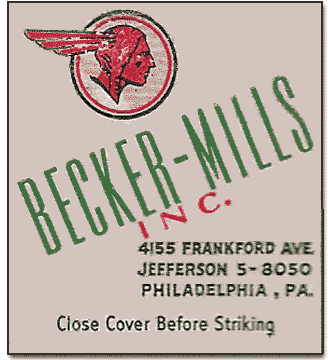 Use-ta Be: Two things you don't see much anymore: advertising matchbooks and Pontiacs.
Use-ta Be: Two things you don't see much anymore: advertising matchbooks and Pontiacs.
Joshua Pusey, a Philadelphia lawyer, invented the safety matchbook in 1892. Diamond Match Company purchased the rights to it in 1894. The matchbook industry peaked in the 1940-50 period. As James Lileks observed, "When more people smoked, more shops and restaurants had a box of matchbooks by the counter, often under a small sign that read "For Our ‘Matchless' Friends." As a small child I knew there was a double meaning there, but I couldn't quite grasp what it was."
Lileks does a great job keeping track of old matchbooks and it was a real treat to see one posted for Becker-Mills Pontiac, a car dealer once located in the Frankford Section of Philadelphia. The dealer's phone number was Jefferson 5-8050 - not many digits away from that of my grandmother, whose telephone number was issued in 1925.
I don't remember this particular dealer; there are references to Becker-Mills in 1957 or so but the firm is not listed in the 1960 Philadelphia Automobile Trade Association roster.
Becker-Mills was located at 4155 Frankford Ave., just past where the Frankford Elevated swings off over Kensington Avenue. Becker-Mills was located across from small but scenic Womrath Park. Legend has it that the park is the location where Thomas Jefferson read the Declaration of Independence out loud for the first time to his friends. The park was then part of a large Frankford estate that was the summer home of Henry Drinker, a prominent Philadelphia Quaker businessman.
As for Pontiac, its days are now over. The brand's sales peaked in 1978 at almost 900,000 vehicles per year.
In the days following World War II, Pontiac was perceived as an Old Man's car but, when Bunkie Knudsen took over as general manager of Pontiac in 1956, he brought engineer John Z. DeLorean on board and set out to transform Pontiac's stodgy image. He removed the twin streaks, disparaging them as "suspenders," ditched the Indian hood ornament and introduced the powerful fuel-injected Bonneville in 1957 at the Daytona Beach races. The 310 horsepower had a top speed of more than 130 mph - a tuned stock model was timed at 144 mph on the Bonneville Salt Flats. For the '59 model year, Bonneville became the designation for top-of-the-line Pontiac models, displacing the old Star Chief. Pontiac was finally turning into a 'hot' car.
Pontiac had become GM's flashy performance brand. Then came the GTO ... but that's another story for another time.
Ultimately, Pontiac got in trouble - as did most GM brands - by offering too many models. By 1985, Pontiac was selling nine distinct models - Fiero, 1000, Sunbird, Firebird, Grand Am, 6000, Bonneville, Grand Prix and Parisienne. As a comparison, Honda offered only three 1985 models - Civic, Accord and Prelude.
Now its gone and Pontiac sightings are becoming as rare as imprinted matchbooks. (posted 4/8/13, permalink)
There's Simply No Accounting For Taste: The Bradford Exchange - which our family has nicknamed 'The Crapford Exchange' for its many forays into kitchy and otiose limited-edition vulgarities - has stooped to a new level in bad taste by offering a 24-inch tall Chevy Bel Air cuckoo clock.
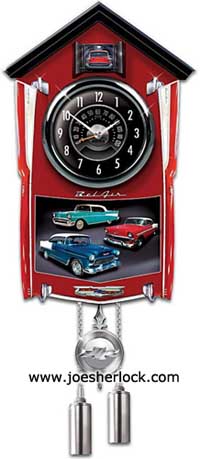
A quartz movement powers the swinging metal pendulum, bearing the official Chevy logo. The clock face is 'inspired' by Chevrolet speedometers of the era.
"Handcrafted with a high-gloss, sculpted metal fascia with chrome detailing inspired by the Bel Air's iconic tailfins, this Chevy Bel Air Cuckoo Clock features images of the '55, '56 and '57 Chevy Bel Air."
If that's not enough, the clock "lights up with sound! At the top of every hour, the garage doors above the clock's face open, and the garage is illuminated to reveal a sculptural 1957 Chevy Bel Air accompanied by the sound of a revving engine!"
The timepiece also comes with a Certificate of Authenticity lest any of your ninnyhammer friends think this China-crafted dreck is a "fake" of some sort. (posted 3/12/13, permalink)
Reminds Me Of A '65 Rambler Marlin: It's really difficult to make a large car look good in fastback form.
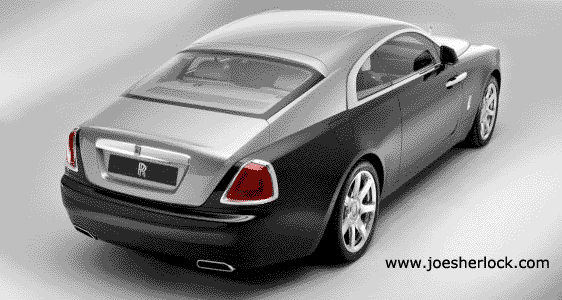
The new Rolls Royce Wraith proves my point. (posted 3/6/13, permalink)
Coming Soon To A Showroom Near You: This photograph is from a Ford Styling Center booklet and was reportedly taken in 1957. It was used to promote the notion that Ford Motor Company was full of exciting new ideas for future cars.
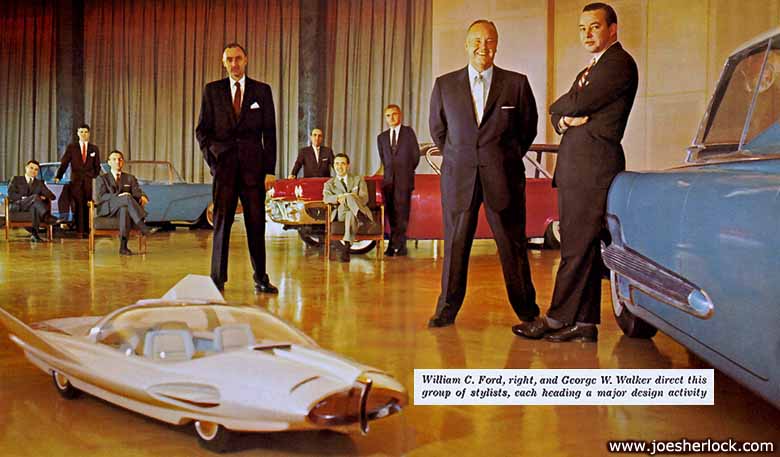
The small model in the foreground is the Ford X-2000, a futuristic styling exercise designed by Alex Tremulous and Bill Balla. It features a bubble top and an Edsel-like grille. Photos of this 3/8th-scale car were published in several period car mags, possibly in an attempt to familiarize the motoring public with the idea of a vertical center grille in advance of the Edsel's introduction.
The light blue car on the right is one of Ford's internal concept cars - it never made an appearance at auto shows or other public events. Called the Diplomat, it was a precursor of the radically-different 1958 Lincoln. The car on the far left is another internal concept car, the Mercury Blue Job. It featured a Strato-Top retractable hardtop. Neither the Blue Job nor the Diplomat had engines or running gear. They were - in the industry vernacular of the day - pushmobiles. The red station wagon in the center is some kind of styling mock-up, possibly an early '58 Mercury proposal.
William Clay Ford, head of the Continental Division is leaning against the Diplomat, while a sunny George W. Walker (Vice President of Design) stands next to him. The tall, dour-looking man is Elwood Engle, Future VP of Design Eugene Bordinat, John Najjar, and Robert MacGuire are also pictured.
George Walker was quite a character and had been in the auto business since the 1920s when he did styling work for the ailing Peerless Motor Company. He worked briefly at General Motors under Harley Earl and, later, Graham Paige. He also worked for Dura, a supplier of automotive components and trim. By the 1940s, Walker had his own design firm and consulted with several car manufacturers. Walker also was part-owner of Trim Trends, an automotive brightwork stamper.
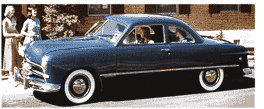 Consultant George Walker was initially retained by his good friend and Ford VP, Ernie Breech, to help with the 1949 Ford design. He remained as an influential styling consultant at Ford until the company hired him as Vice-President of Design in 1956.
Consultant George Walker was initially retained by his good friend and Ford VP, Ernie Breech, to help with the 1949 Ford design. He remained as an influential styling consultant at Ford until the company hired him as Vice-President of Design in 1956.
Actual design of the production '49 model has been variously attributed to Joe Oros, Virgil Exner, Bob Thomas, Bob Bourke, Dick Calleal, Holden Koto and others. But Walker made the final presentation and claimed credit for it. Walker was a better salesman than designer, successfully promoting concepts created by his minions and gaining approval from management.
According to Bob Bordinat, "George, probably as a result of his being a consultant to the project of the '49 Ford, had all of the bright work on the exterior of that automobile done in Trim Trends. In fact, he had the whole front end ensemble, all of the side moldings, all of the trim around the back end of the car and so forth - everything that was stamped. I suppose today that would be considered a terrible conflict of interest. But, even after George became vice president of the corporation in 1956, he - with full disclosure - advised that this was a conditional acceptance on his being able to retain his holdings in Trim Trends."
Bordinat said that "George was just a horny, old goat" who bedded a lot of women on his office's black Mouton carpeting. When 'Time' magazine did a feature article on Walker, he was referred to as "Cellini of Chrome." This was a big joke at Time and Ford. Walker willingly told Time reporters about his many sexual conquests and thought the phrase was a great compliment, never realizing that Benvenuto Cellini was a 16th Century painter, sculptor, notorious womanizer and bisexual sodomizer.
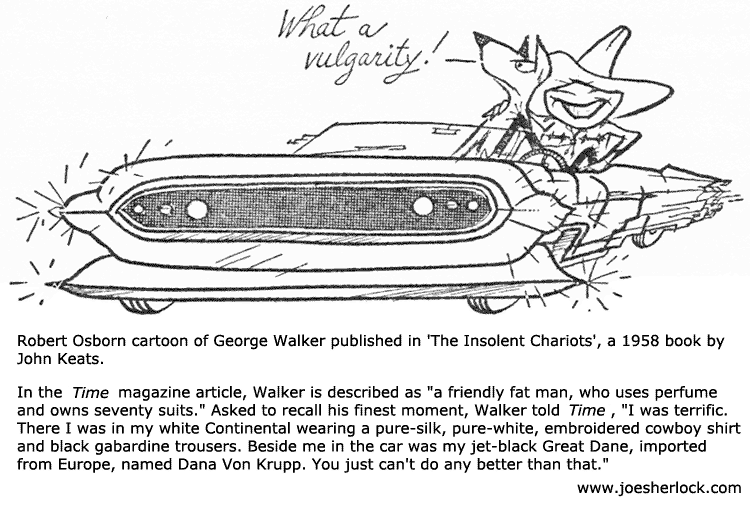
George W. Walker was already a wealthy man when he arrived at Ford and, between his executive pay and perks as well as his considerable income from Trim Trends, he became even richer. Walker retired from Ford Motor Company in 1961 and died in 1993 at age 96. (posted 1/18/13, permalink)
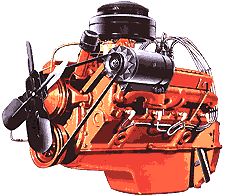 Rumble: The Bentley Continental can now be had with an Audi-sourced V8 instead of the Volkswagen W12. MotorWeek road tested it and said something to the effect that the V8 had a throaty roar which sounded a lot better than the W12.
Rumble: The Bentley Continental can now be had with an Audi-sourced V8 instead of the Volkswagen W12. MotorWeek road tested it and said something to the effect that the V8 had a throaty roar which sounded a lot better than the W12.
At last, someone has admitted it: If you're looking for a powerful engine sound, there's something magical about a V8. There's an enticing burble at idle and low speeds which becomes a rumble as rpms increase.
While various manufacturers' offerings sound a bit different from one another, all V8s sound good - flathead Ford, small block Chevy, '50s Olds Rocket, Ford 302s, et al. Even though my Lexus is muffled tighter than Dean Martin after six Harvey Wallbangers, I can still hear that burble when I've got the windows down. There's no sensation like opening all the windows of a V8 powered vehicle as you approach a tunnel, turning down the radio and listening to the engine music bounce off the walls.
I've heard both modern Ferrari V12s and ancient flathead Lincoln V12s and they just don't sound very good. The Viper V10? Forget it - sounds awful.
Six-cylinder cars? Meh. Some sound OK I guess, but none of them have that burble peculiar to V8 engines. The Jaguar straight-six may be the best of the bunch. Straight eights? Duesenbergs sound very nice (no burble though) but Buick and Pontiac - not so much.
Fours are usually bland and - if unmuffled - pretty annoying. And blatty.
Someday in the future, there will be no more V8 engines. That's sad to contemplate - depriving future generations of those unique mechanical musical sounds - but I'm glad I still have a couple of V8-powered cars in my garage. (posted 1/10/13, permalink)
Earlier Car Musings can be found here.
Other Pages Of Interest
| blog: 'The View Through The Windshield' |
| essays: greatest hits | blog archives | '39 Plymouth | model train layout |
| about me | about the blog | e-mail |
copyright 2013-20 - Joseph M. Sherlock - All applicable rights reserved
Disclaimer
The facts presented on this website are based on my best guesses and my substantially faulty geezer memory. The opinions expressed herein are strictly those of the author and are protected by the U.S. Constitution. Probably.
Spelling, punctuation and syntax errors are cheerfully repaired when I find them; grudgingly fixed when you do.
If I have slandered any brands of automobiles, either expressly or inadvertently, they're most likely crap cars and deserve it. Automobile manufacturers should be aware that they always have the option of trying to change my mind by providing me with vehicles to test drive.
If I have slandered any people or corporations, either expressly or inadvertently, they should buy me strong drinks (and an expensive meal) and try to prove to me that they're not the jerks I've portrayed them to be. If you're buying, I'm willing to listen.
Don't be shy - try a bribe. It might help.

